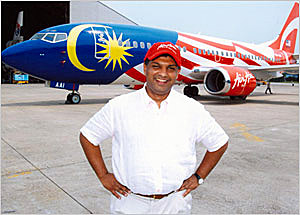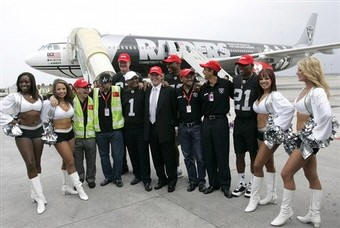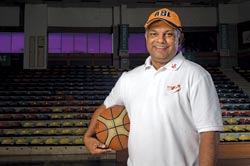AirAsia's unconventional adventure
Since launching with a couple old airlines and millions in debt, maverick entrepreneur Tony Fernandes has ramped up AirAsia to unimagined heights, defying critics as he devised Asia's - and one of the world's - best budget airlines. With new long-haul flights to London, a link with America's renegade Oakland Raiders and a string of cut-rate Tune Hotels, is there any limit to this high-flying exec?
By Ron Gluckman/Kulua Lumpur, Bangkok and Phnom Penh
NOBODY HAS SOARED HIGHER on little more than a wing and a prayer than Tony Fernandes, the boisterous Malaysian entrepreneur. In 2001, the cherubic boss of AirAsia paid a token fee of 1R (about 26 cents) for a failing Malaysian airline that had a pair of old Boeings and $11m of debt.
 From the
beginning, he focused on a simple but significant goal: to create Asia’s first
low-cost airline and realize its slogan “now everybody
can fly”. While low-cost airlines had been around in Europe and America for many
decades, few would have bet on an Asian upstart making it.
From the
beginning, he focused on a simple but significant goal: to create Asia’s first
low-cost airline and realize its slogan “now everybody
can fly”. While low-cost airlines had been around in Europe and America for many
decades, few would have bet on an Asian upstart making it.
Although he had a grounding in Sir Richard Branson’s Virgin group, Fernandes was in the music rather than the aviation division. An accountant, he spent 14 years in the music industry, most of it with Time-Warner where he became one of its youngest directors in Asia.
In addition to his lack of aviation experience, his timing also seemed monumentally wrong. He took over the hapless airline only days after the double whammy that destroyed New York’s World Trade Center. With the atrocity sending the aviation industry into a tailspin, AirAsia’s motto at the outset might as well have been “now nobody is flying”.
Fernandes says: “All the sceptics were there when I started AirAsia, but I proved them wrong,” Within a year he had cleared the airline’s debt and it was modestly profitable. From the start he pushed cut-rate prices, relentless growth and maximum efficiency. Plane turnaround times were slashed from hours to minutes, squeezing more flights out of every craft.
And taking their lead from Branson’s hands-on style, management, pilots and even Fernandes – in jeans and trademark red baseball cap – pitched in to clean and unload planes. Leading from the front worked in terms of staff morale and earned bucket loads of customer loyalty.
Today, AirAsia is an underdog no more and growth is said to have increased by 20%-30% a year. It carried 11.8m passengers in 2008 and with the addition of new routes from Japan, China, India and Australia it hopes to double that figure. Forbes magazine recently listed him and Kamarudin Meranun, his long-time AirAsia partner, among the top 20 wealthiest Malaysians, estimating his worth at $220 million.
He has also opened a chain of low-cost hotels, a courier service in Malaysia and will see his local sports dreams come true with this month’s launch of the Asean Basketball League (ABL), of which he is the chairman.
 Fernandes says the ABL is destined to boost sporting excellence throughout the
region and include teams from Malaysia, Philippines, Brunei, Indonesia,
Singapore and Thailand. Its inaugural season continues through to February 2010.
Fernandes says the ABL is destined to boost sporting excellence throughout the
region and include teams from Malaysia, Philippines, Brunei, Indonesia,
Singapore and Thailand. Its inaugural season continues through to February 2010.
“To see how this idea has developed is very exciting,” says an elated Fernandes of his pet project. “Now with TV deals, sponsors in place and the teams all raring to go, the ABL will be ready to take the region by storm.”
Despite his almost manic “out of the box’” thinking, many would call him an unlikely choice for the entrepreneurial role.
The son of Goan and Malaccan parents of Portuguese heritage, he was sent to England to study at the age of 12. His father wanted him to be a doctor but instead he graduated from the London School of Economics and began work as an accountant.
A musician– he plays guitar and “some piano” – he quickly gravitated to the record industry and concedes that he’d love to return if the prospects were better.
“Music is really my love,” he confides, and it shows in his business model. His hotels run under the Tune brand; the airline was initially called Tune Air.
His everyday focus, though, is on flying. He recently realized a long-term dream by launching AirAsia X, an affiliated carrier that aims to become a successful, low-cost, long-haul airline. In March, after long delays, it began budget flights from London (Stansted) to Kuala Lumpur, AirAsia’s largest hub. From there, passengers can connect to many of the more than 120 routes that AirAsia flies.
Since takeoff in 2001, his company has become one of the region’s biggest home-grown success stories, making Fernandes a multi-millionaire many times over, yet he’s changed little. He even wears his red baseball cap to meetings, and calls things as he sees them, running his business with a feisty individualistic streak.
Never one for consultants and lengthy studies, when he considered launching the airline, Fernandes did the research himself. He flew to Europe and went to the major hubs of the top low-cost airlines. With a handheld camera, he filmed operations and chatted to passengers. He decided what could work in Asia – one of the last big regions to get low-cost carriers.
“Why did it take so long? You might ask: why did the iPod take so long? It’s a logical piece of equipment, so obvious,” he says. “There’s a fine line between brilliance and stupidity. It just took someone like me to weld it all into place and presto. It just took one person with the balls to do it.”
 Yet none
of his other ventures have taken off as quickly as AirAsia.
Yet none
of his other ventures have taken off as quickly as AirAsia.
Tune Hotels follows the same low-cost formula. Launched several years ago, there are still only a handful of them in Malaysia, although Fernandes says there will be more added soon in Bali and Thailand. “The hotels are doing fantastic,” he insists. “This is a wonderful model, and perfectly suited to hotels.” Growth, he suggests, has been slowed by the economic situation and a lack of financing.
Some say the results are directly tied to Fernandes' style. He eschews research in favor of his instincts, and is outspoken in a way that seems all the more rare among Asia's cautious CEOs.
“He’s extremely unconventional, and impulsive,” says one AirAsia employee, who requested anonymity. Contact is always direct and personal – he has no use for the batteries of public relations people or image shapers employed by other executives. In a region where caution and closed doors are the general rule in boardrooms, he’s talkative, open-minded and switched on. He maintains his own blog, answering queries personally.
He admits his flamboyant style can cause trouble. “If I did it all over again, I wouldn’t change a thing,” he says. “Maybe keeping my mouth shut once in a while would be better, but I don’t regret anything.” As to mistakes, he admits many. “But all mistakes are good,” he says. “You cannot learn without them.”
Fernandes has evolved into a canny executive, playing on his underdog image to muster publicity or devising crafty word-of-mouth schemes. AirAsia regularly discounts routes to pennies per seat, generating a booking flurry that only massive advertising could otherwise create. He’s also garnered publicity with million-seat giveaways.
Many in the airline industry were baffled – and not for the first time – by his partnership with Manchester United football club in England, because AirAsia had no flights to Europe. As an executive who mingles with his customers, he knew the team claimed a fanatical following across Asia and the deal propelled AirAsia into the news at little cost.
 In
2007 he arranged a three-year deal to sponsor English premier league officials,
obtaining exposure for his brand in the world’s most popular sporting league at
a fraction of the cost of sponsoring one of its clubs.
In
2007 he arranged a three-year deal to sponsor English premier league officials,
obtaining exposure for his brand in the world’s most popular sporting league at
a fraction of the cost of sponsoring one of its clubs.
Just a few months ago he was at it again on another continent. He signed a deal with the piratical Oakland Raiders, perhaps the most distinctive American football team on account of its renegade attitude. Fernandes admits AirAsia has no flights planned any time soon to the USA “but we’re working on it”.
He plans to paint a plane silver and black – the team’s colours – and fly to California this month with celebrities such as Arnold Schwarzenegger, the governor of California, aboard. Such stunts show how he has grown into the role of media star.
Even though many make the inevitable comparisons between him and his Branson, his former boss, they are actually little alike. A jetsetter and mainstay on the global party scene, Branson regularly graces gossip pages with his charisma and penchant for pretty women, fast cars and grand schemes.
In contrast, 45-year-old Fernandes is a family man with two children, who would be happy to stay in the shadows devising routes and diligently making them profitable in true accountant’s style.
His advice to other entrepreneurs is simple. Pick something you would like to do, and pursue it relentlessly. “You have to have a passion for what you do, otherwise it makes no sense,” he says. “Running a low-cost airline is a massive buzz. It’s like sex. For me, this is satisfying, totally satisfying, otherwise it wouldn’t be worth all the pain. And believe me, there has been plenty.
 “But I tell you what makes it all worth it. Every day someone comes up to
me in an airport and greets me and says, ‘Thank you. Before, I couldn’t fly.
Now, I can visit my family. So thank you.’ That makes it all worthwhile for me.”
“But I tell you what makes it all worth it. Every day someone comes up to
me in an airport and greets me and says, ‘Thank you. Before, I couldn’t fly.
Now, I can visit my family. So thank you.’ That makes it all worthwhile for me.”
AirAsia’s growth seems to have no limit. Last December, Fernandes finally wrestled one of the golden rings of Asian aviation – the lucrative Singapore-Kuala Lumpur route – from a state airline monopoly. Flights that once cost $275 return are now sold by AirAsia for as little as $40 with advance booking.
Similarly, flights between Bangkok and Phnom Penh used to cost $250-$350 with Bangkok Airlines and Thai Air. The Thai carriers had the audacity to schedule flights at identical times, as if flaunting their cartel-like advantage. When AirAsia began promotional rates of $20, both quickly cut prices by 60%-70%.
Such price-busting moves combined with an ability to offer direct links to smaller cities, often overlooked by bigger carriers, has won AirAsia accolades and surging passenger share.
Even Malaysian Airlines, long time and occasionally bitter rival, has abandoned its aloof attitude and begun copying some of his ideas.
Not that all is rosy for Asia's red-and-white budget airline. AirAsia posted its first quarterly loss last year, but has since returned to profit. It continues to push all of its resources into aggressive expansion. With low-cost airlines the competition is for routes, which can be heavily discounted in order to build the winning network. Expansion takes precedence over profit.
 For the
future he plans to manage his airline as he always has: full speed ahead,
ramping up in emerging markets such as India and China. “India will be massive.
We’re looking at 10 destinations and will add them within 12 months. China is
going great. We have eight destinations and plan to add five more this year.”
For the
future he plans to manage his airline as he always has: full speed ahead,
ramping up in emerging markets such as India and China. “India will be massive.
We’re looking at 10 destinations and will add them within 12 months. China is
going great. We have eight destinations and plan to add five more this year.”
Fernandes brushes aside criticism of the long-haul AirAsia X venture. “I think it’s good to have all the sceptics. If they weren’t all saying this was impossible,” he says, “then there would be no room for little Tony to prove them wrong.”
He clearly relishes playing David to the aviation world’s Goliaths. He also expects the rest of the world to follow suit, even though low-cost, long-haul airlines have launched and crashed regularly in the past.
At August’s Paris Air Show, AirAsia X ordered 10 Airbus A350s, which can seat 425 passengers, at a list price of $2.2 billion, with options for five more. It is already the world’s biggest customer for Airbus A320s, with a firm order for 175 aircraft and the option of 50 more signed in 2005. When all the aircraft are delivered within nine years, Fernandes hopes to exploit new economies of scale.
“We have the right model for this time. We’re Wal-Mart, we’re Costco,” he says, and figures bear him out. While other airlines suffer, AirAsia continues to increase market share. “People still want to travel, but they don’t want to spend a lot. We’re in a perfect place; we’ve found our sweet spot.”
Ron Gluckman is an American journalist who has been working and living in Asia since 1991, roaming around the region for a wide variety of publications, most of that time stuck on high-priced carriers because of a lack of competition. This story ran in the inaugural edition of Southeast Asia Globe magazine in September 2009 .
For another story on Tony Fernandes and Air Asia, see Now Everyone Can Fly.
Pictures are by Ron Gluckman, Air Asia and Southeast Asia Globe
To return to the opening page and index
push here
[right.htm]
